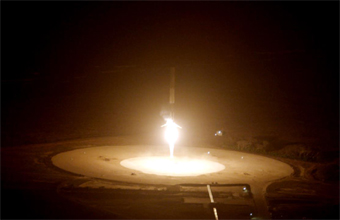
Image courtesy of SpaceX/NASA
SpaceX Launch a Success:
Vertical Landing Even Bigger Success
| published December 22, 2015 |
By R. Alan Clanton, Thursday Review editor
NASA and SpaceX resumed their technological relationship with a successful launch on Monday of a Falcon 9 rocket, atop which was a payload of a dozen satellites owned by various space vendors, including ORBCOMM, the primary customer for Monday’s launch.
This was the first SpaceX launch since it last rocket—a cargo vessel ferrying supplies to the International Space Station—exploded minutes after takeoff in June 2015.
SpaceX (full name: Space Exploration Technologies) is a California-based company owned by Elon Musk, a technologist and billionaire who also owns the auto maker Tesla and a dozen related high tech companies.
Monday’s launch vindicates SpaceX after a costly failure in which a faulty strut was eventually found to have impacted the integrity of the upper stage liquid oxygen tank, causing a rupture and explosion, destroying a Dragon spacecraft carrying 5000 pounds of supplies and hardware for the space station.
But there is even more to SpaceX’s accomplishment than getting a rocket into space without an explosion and loss of payload. SpaceX also, for the first time, successful guided part of a rocket back to Earth—landing the 15-story behemoth vertically, and intact, a goal established by Musk in his early planning for SpaceX technology. SpaceX has attempted the tricky act of a vertical landing on specially designed floating barges at sea, but those landings failed.
Monday’s landing—just minutes after take-off—is a first for the history of space flight. Experts suggest it may usher-in a new era in which large rockets can engage in vertical landings back on Earth, or on other planets—a key piece of the complex puzzle of successfully taking humans to Mars and back, and for making the ever-expanding business of space activity less costly. The vertical landing will also introduce an era in which the large boosters and rockets can be easily and effectively reused, without the costly process of retrieving items at sea, or, worse, having to reconstruct replacements from scratch.
A few minutes after the Falcon 9 rocket completed its soft landing on Earth, Musk tweeted to millions of followers “welcome back, baby.”
SpaceX’s previous attempts at vertical landings of its rockets and boosters were close calls—attempts in which there was only about a 50% chance of success, by Musk’s own admission. The last attempt was a “near success” in which the rocket tipped slightly only a dozen feet before it touched down on a specially-constructed platform at sea.
Amazon successfully achieved its own vertical landing of a spacecraft in November of this year using one of its Blue Origin fleet of rockets. The Amazon feat was, however, achieved after a short suborbital test flight. SpaceX is one of several high tech companies now competing aggressively for marker share in space launches and orbital activity. Amazon also seeks to create a permanent space presence, as does Google and Virgin.
The vertical landing of the rocket was nearly as dramatic as the launch; in the moments before the rocket came back into Earth’s atmosphere, it triggered a sonic boom, leading some inside buildings near Cape Canaveral to fear the rocket had exploded. Musk himself assumed the booster had met disaster on its way to the landing site. He was overjoyed later to learn the Falcon9 had landed intact.
All 11 satellites aboard the rocket were successfully inserted into Earth orbit.
Related Thursday Review articles:
Falcon 9 Explodes After Launch; Thursday Review staff; Thursday Review; June 28, 2015.
A New Record for Time in Space; Thursday Review staff; Thursday Review; October 16, 2015.
